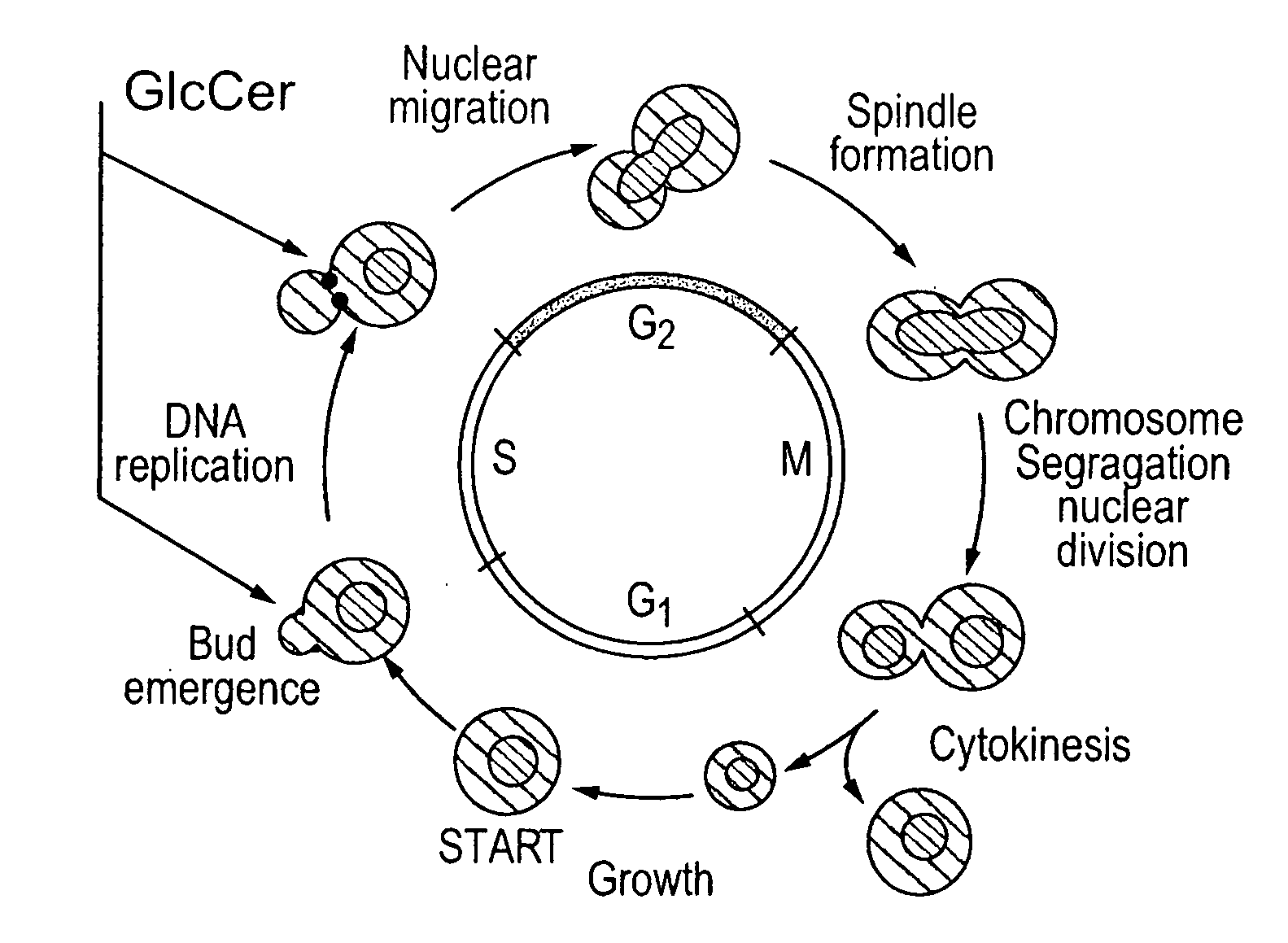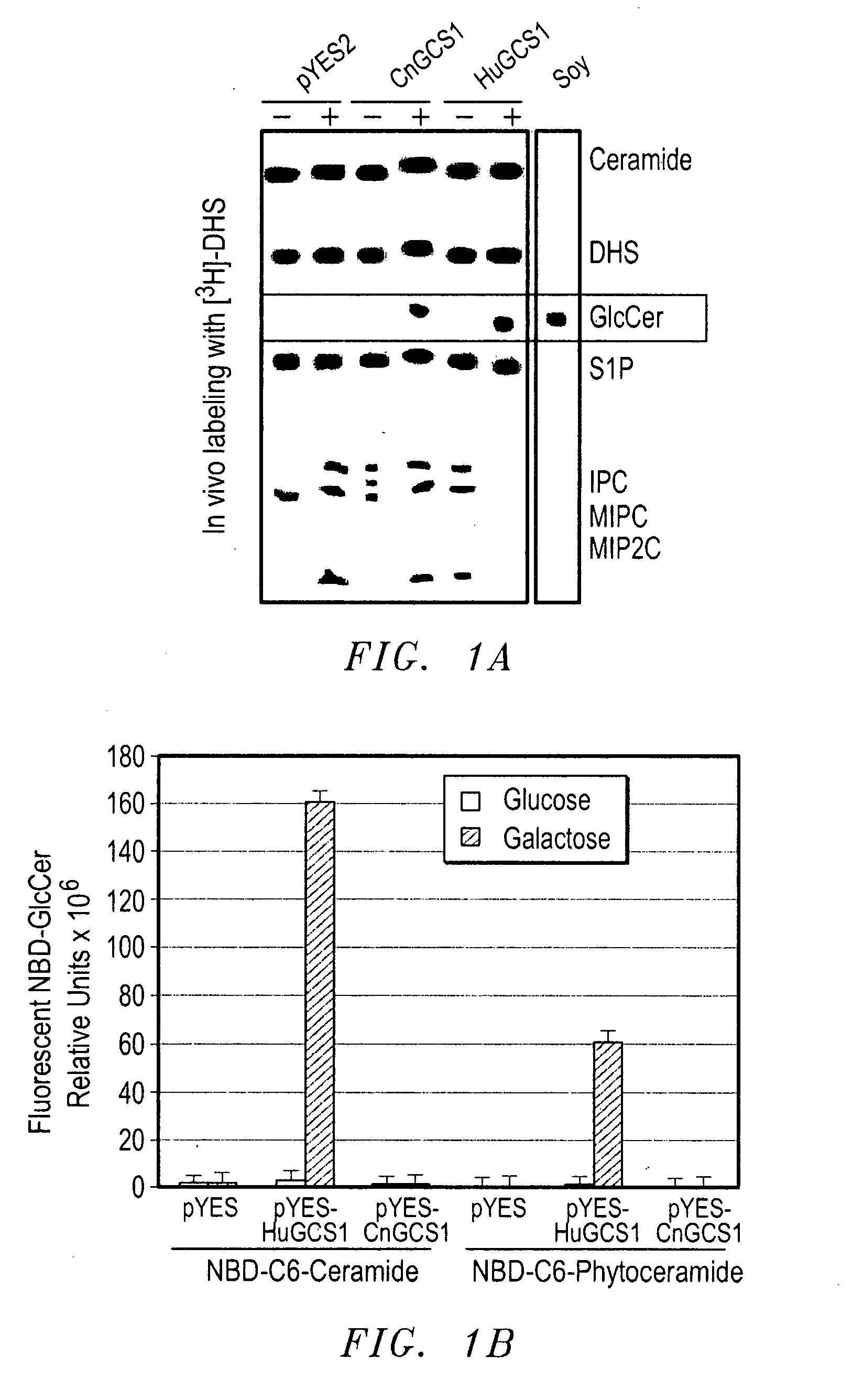Methods For The Diagnosis And Treatment of Fungal Infections Caused By Microorganisms Producing Glucosylceramide
a technology of glucosylceramide and antifungal drugs, applied in the field of molecular biology, can solve the problems of insufficient effectiveness of current antifungal drugs, and achieve the effect of reducing the amount of ammonia
- Summary
- Abstract
- Description
- Claims
- Application Information
AI Technical Summary
Benefits of technology
Problems solved by technology
Method used
Image
Examples
example 1
[0097] The pathogenic fungus Cryptococcus neoformans (Cn) infects humans upon inhalation and causes the most common fungal meningo-encephalitis in immunocompromised subjects worldwide. In the host, Cn is found both intracellularly and extracellularly, but how these two components contribute to the development of the disease is largely unknown. Here we show that a glycosphingolipid, glucosylceramide (GlcCer), present in Cn is essential for fungal growth in host extracellular environments, such as in alveolar spaces and in the bloodstream, which are characterized by a neutral / alkaline pH, but not in the host intracellular environment, such as in the phagolysosome of macrophages, which is characteristically acidic. Indeed, a Cn mutant strain lacking GlcCer cannot grow in vitro at neutral / alkaline pH whereas has no growth defect at acidic pH. The mechanism by which GlcCer regulates alkali tolerance is by allowing the transition of Cn through the cell cycle. This study establishes Cn Glc...
example 2
[0140] Although other investigators have shown the presence of antibody against glucosylceramide in sera of patients affected by cryptococcosis, it is not known at which stage of the cryptococcal disease these antibodies are produced. Thus, the have tested inventors are currently testing human clinical samples for the presence of anti-glucosylceramide antibody using an ELISA assay in various patient populations (e.g., those affected by cryptococcosis with and without fungal meningo-encephalitis).
[0141] The presence of anti-glucosylceramide (anti-GlcCer) antibodies in human fluids of patients with cryptococcosis will be determined and evaluated. In preliminary studies, the inventors showed that some patients affected with cryptococcosis produced antibody anti-GlcCer, but it was not known whether the level of this production would be constant during the infection nor was the host immune status at the time of blood sampling known. Thus, an epistasis analysis of the determination of an...
example 3
[0148] A. Materials and Methods
[0149] Strains, media and reagents. C. neoformans var. grubii serotype A H99-derived strains Δgcs1 and Δgcs1+GCS1 are previously described in great detail (Rittershaus et al., 2006). H99 (wild-type) and H99-derived strains Δgcs1 and Δgcs1+GCS1 were grown in yeast extract / peptone / 2% dextrose (YPD) media from Difco. YPD plates used were supplemented with chloramphenicol (100 μg / ml) and ampicillin (100 μg / ml). All reagents used are from Sigma Chemical Co. (St. Louis, Mo.) unless otherwise specified.
[0150] Animal studies. Four to six-week-old Tgε26 mice (Wang et al., 1994; Wang et al., 1997), available in our Animal Core Facility, Medical University of South Carolina, Charleston, S.C., were used for this study. Mice were anesthetized with an intraperitoneal injection of 60 μl xylaxine / ketamine mixture containing 5 mg xylazine and 95 mg ketamine per kilogram of body weight. Wild-type and mutant strains of Cn were grown in YPD media for 24 hrs at 30° C. Th...
PUM
| Property | Measurement | Unit |
|---|---|---|
| pH | aaaaa | aaaaa |
| pH | aaaaa | aaaaa |
| temperatures | aaaaa | aaaaa |
Abstract
Description
Claims
Application Information
 Login to View More
Login to View More - R&D
- Intellectual Property
- Life Sciences
- Materials
- Tech Scout
- Unparalleled Data Quality
- Higher Quality Content
- 60% Fewer Hallucinations
Browse by: Latest US Patents, China's latest patents, Technical Efficacy Thesaurus, Application Domain, Technology Topic, Popular Technical Reports.
© 2025 PatSnap. All rights reserved.Legal|Privacy policy|Modern Slavery Act Transparency Statement|Sitemap|About US| Contact US: help@patsnap.com



